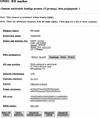A comprehensive view of human chromosome 1
- PMID: 10523526
- PMCID: PMC310818
- DOI: 10.1101/gr.9.10.978
A comprehensive view of human chromosome 1
Abstract
Comprehensive representations of human chromosomes combining diverse genomic data sets, localizing expressed sequences, and reflecting physical distance are essential for disease gene identification and sequencing efforts. We have developed a method (CompView) for integrating genomic information derived from available cytogenetic, genetic linkage, radiation hybrid, physical, and transcript-based mapping approaches. CompView generates chromosome representations with substantially higher resolution, coverage, and integration than current maps of the human genome. The CompView process was used to build a representation of human chromosome 1, yielding a map with >13,000 unique elements, an effective resolution of 910 kb, and a marker density of 50 kb. CompView creates comprehensive and fully integrated depictions of a chromosome's clinical, biological, and structural information.
Figures




References
-
- Benham F, Hart K, Crolla J, Bobrow M, Francavilla M, Goodfellow PN. A method for generating hybrids containing nonselected fragments of human chromosomes. Genomics. 1989;4:509–517. - PubMed
-
- Bernardi G. The isochore organization of the human genome. Annu Rev Genet. 1989;23:637–661. - PubMed
-
- Boguski MS, Schuler GD. ESTablishing a human transcript map. Nat Genet. 1995;10:369–371. - PubMed
-
- Brown DM, Matise TC, Koike G, Simon JS, Winer ES, Zangen S, McLaughlin MG, Shiozawa M, Atkinson OS, Hudson JRJ, et al. An integrated genetic linkage map of the laboratory rat. Mamm Genome. 1998;9:521–530. - PubMed
-
- Chee M, Yang R, Hubbell E, Berno A, Huang XC, Stern D, Winkler J, Lockhart DJ, Morris MS, Fodor SPA. Accessing genetic information with high-density arrays. Science. 1996;274:610–614. - PubMed
Publication types
MeSH terms
Substances
Grants and funding
LinkOut - more resources
Full Text Sources
